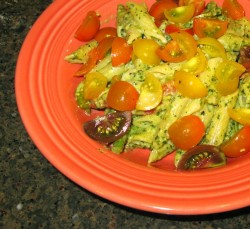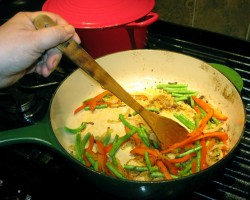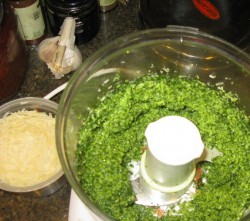Meatless Monday: Summer Vegetables+Pasta+Pesto=Dinner
I know that I have written a lot about pesto recently. Long-time readers should know that I will put it on almost any vegetable.
Which, as far as I am concerned, makes pesto a most versatile kitchen ally when you are striving to eat more vegetarian meals.
Basically, the versatility of pesto as a sauce for vegetables and pasta, means that you can pair it with nearly any combination of summer vegetables you happen to have in your possession, taking into account the cooking methods necessitated by each vegetable.
Some vegetables can be sauteed just as they are.
Some vegetables can be sauteed, but need to be blanched first.
And some vegetables can be added to the pasta at the last minute when they are essentially raw.
And that is what this post is about–which vegetables go into which category, along with ideas for various combinations which I and my family find to be most delicious.
Vegetables to Saute Just As They Are
Onions, small summer squashes, bell peppers, hot peppers, mushrooms, chard, kale, broccoli rabe, sugar snap peas, young collard greens, small eggplant.
These are the easiest vegetables to prepare–you just cut them, preferably in analogous shapes that echo the shape of whatever pasta you are using, heat up a bit of olive oil in the pan and start sauteing. If you use onions, they go in first. I like to at least get them golden before anything else goes in. Then, if you are using peppers or mushrooms, in they go next. Then, you can add squashes or eggplants–both cut very thinly. (If you use very small or young eggplants or the elongated Japanese kind, you don’t have to salt them to remove bitter juices before you cook them.) Snap peas would go in next, with the greens, kale, collards, chard and broccoli rabe being cooked for the shortest period of time.
Vegetables to Saute After Blanching
Broccoli, cauliflower, carrots, shelled peas and green beans (even haricot vert are better if they are blanched briefly before sauteing).
These vegetables are great with pesto and pasta, but they need to be softened up a bit by blanching them in boiling water for a minute or two, before you add them to the saute pan. Once again, cut them up into shapes and sizes that are analogous to each other and the pasta shape you have chosen. (You can tell I have cooked a lot of Chinese foods.) Dunk each of them into a pot of boiling water for a minute or two, just until they are softened, and then drain them. You don’t need to shock them in cold water–just drain them and put them into the saute pan with whatever other vegetables you are using–usually near the middle or end of the sauteing process.
The blanching just softens up the tissues of these harder vegetables and makes them more receptive to the process of cooking in the saute pan and makes them more likely to soak up the flavors of the sauce.
Oh, and by the by–I just use the already boiling pasta water pot to blanch my vegetables. Why boil two pots of water for one dish? I just blanch the vegetables first and then, after they are out of the pot and into the pan, I add the pasta.
Vegetables to Be Added At The End
Tomatoes and spinach.
That is a short list, isn’t it?
You can, of course, cook either of these vegetables a bit, but I have found that if you toss raw baby spinach with hot pasta into which are you stirring pesto, it will wilt just perfectly without having to take the chance of overcooking it. As for tomatoes, you can cook them, of course, but I really, really like the flavor and texture of wedges of them added raw to the pasta and then tossed with everything else. The heat of the pasta and other vegetables do indeed cook them a bit, but they still retain their color, fresh flavor and texture, which contrasts nicely with the cooked vegetables and pasta.
How It All Comes Together
So, the cooking method goes something like this:
Start your pasta water boiling.
Cut up your vegetables so they are close to the same shape and size and so they go with your pasta shape.
Put all of the pesto ingredients into your food processor except for the olive oil.
Start sauteing your vegetables–putting the ones that take the longest to cook in first, and blanching and draining the ones which need to be blanched before going into the saute pan. After most of your vegetable cooking is done, add some wine or vegetable broth if you wish, and a bit of cream–as little as a quarter cup will work. (This helps everything to cling to the pasta and adds a bit of moisture to the pesto sauce. The cream also helps the pesto stay green.) Take the saute pan off of the heat. It will stay warm, but you don’t want the vegetables to over-cook.
When your vegetables are nearly done, put the pasta in the boiling water, salt it and start the pesto. Remember to drizzle the olive oil into the feed tube of the food processor while it is whirring about or your pesto will be really pasty and funny-tasting.
When the pasta is done, drain it, and either put it back into the cooking pot, or dump it right into your saute pan. (Which one you do depends entirely on how big your saute pan is. I have big ones, so that is how I do it–if yours is not big enough, put the pasta back into the cooking pot and dump the vegetables on top.) Add either baby spinach or tomatoes if you are using them, and then scoop however much pesto you want into the pot and start tossing and don’t stop until everything is coated in a lovely haze of green sauce.
Really Tasty Combinations of Vegetables for Pesto and Pasta
The one pictured here is onions, red bell peppers, haricot vert and cherry tomatoes.
But you could also do:
Onions, baby squashes and tomatoes.
Onions, bell peppers and broccoli.
Onions, mushrooms, and peas (or spinach–yum!).
Onions, broccoli rabe or kale, and mushrooms.
Onions (do you get the idea that I like onions?) bell peppers, spinach and tomatoes.
Onions, cauliflower and spinach.
The possibilities are nearly endless.
And–you could always ditch the pasta and instead use boiled fingerling potatoes along with whatever combination of summer vegetative goodness you can get your hands on.
1 Comment
RSS feed for comments on this post.
Sorry, the comment form is closed at this time.
Powered by WordPress. Graphics by Zak Kramer.
Design update by Daniel Trout.
Entries and comments feeds.






This is a really great list although I generally just stir fry my broccoli. I suppose it depends on the application though. This is a great point of reference for the future!
Comment by Zebe912 — August 17, 2009 #